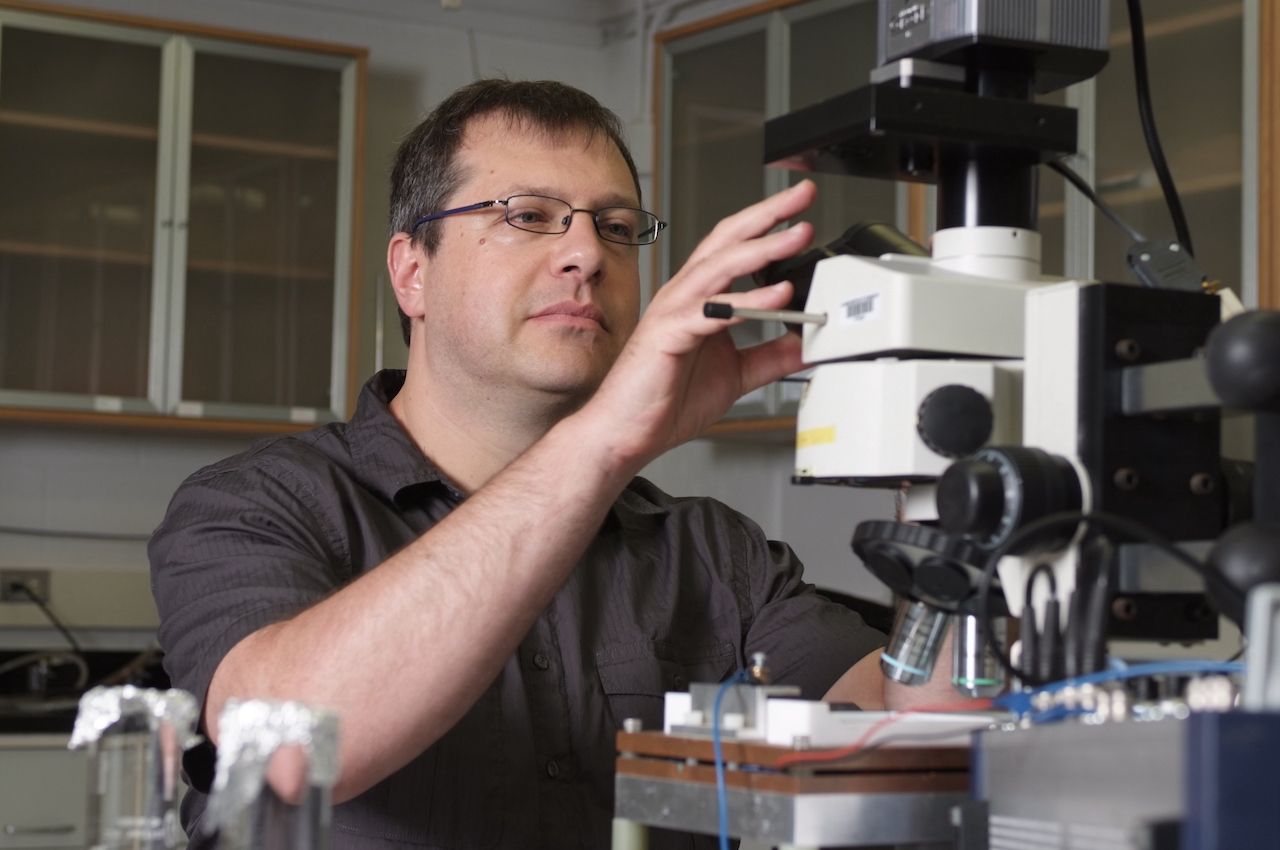A Breath of Fresh Air: Illinois Tech Professor Leads Discovery on Lung Function

Take a long, deep breath. In through your nose, and now hold it in your lungs for a few seconds. Finally, exhale.
It sounds relaxing, but for Illinois Institute of Technology Associate Professor of Physics David Gidalevitz, the act of breathing is the subject of his research. Gidalevitz published a paper that dives deeper into lung function—“DPPC and Cholesterol Form Crystalline Structure Responsible for Pulmonary Surfactant Resistance to Collapse”—in Biophysical Journal in February 2024.
The paper, based off findings from a $2.4 million National Institutes of Health grant, explains a crucial part of lung function that, until now, had not been fully understood by the scientific community.
Key to the lungs’ ability to expand and contract is a substance called pulmonary surfactant, which is comprised of a mixture of lipids, cholesterol, and proteins. The film-like material covers the millions of tiny alveoli (air sacs) lining the inside of the lungs. With properly functioning surfactant, the lungs can expand and contract normally without issue. Without properly functioning surfactant, however, the lungs fail.
“Interestingly, even though this is such an important thing for any mammal, we know very little about how it works,” says Gidalevitz. “This level of expansion and contraction—if you translate it into scientific language, it would be the ability of surfactant to achieve a very low surface tension for the surfactant. What is happening? What molecular structures within the pulmonary surfactant are responsible for such ability? Scientists have been asking these questions for years, but not clear how that happens.”
Pulmonary surfactant is first produced inside the lungs of a fetus during pregnancy. Because it is produced late in a pregnancy—typically well into the third trimester—nearly 30 percent of premature infants that are admitted to neonatal intensive care units develop significant respiratory morbidity, according to the NIH.
“If the birth is premature and pulmonary surfactant is not yet produced, the newborn baby tries to take their first breath and its lungs are torn apart right then and there because they cannot extend when filled with the air,” says Gidalevitz.
A treatment has been known since the middle of the twentieth century: pulmonary surfactant is extracted from lambs, pigs, and cows and placed inside the lungs that lacked it.
“The problem is that it’s extremely expensive. Everything you use is extracted from an animal,” says Gidalevitz. “Being that it’s very expensive, it’s not available to everyone. So that’s a partial solution, but not really a solution.”
For decades, synthetic versions of pulmonary surfactants did not use any cholesterol. The general thinking was that a lipid called dipalmitoyl phosphatidylcholine (DPPC) alone was the only thing necessary to keep the surfactant in a low surface tension.
So what have Gidalevitz and his colleagues—his research is being conducted with scientists from the University of Chicago and the Oregon Health and Science Center—discovered?
By conducting X-ray experiments using the Synchrotron Advanced Proton Source at Argonne National Laboratory, the team has learned that cholesterol plays an important role in this process. The surfactant that best resists the collapse consists of a 3:1 DPPC-to-cholesterol ratio.
This means that the door is open to produce synthetic surfactant less expensively, and the team believes the addition of cholesterol will likely result in more effective treatments.
“There are synthetic surfactants without cholesterol that work—not very well, but they work,” says Gidalevitz. “We hope to achieve that they’ll work better, and synthetics will make it cheaper.”
While Gidalevitz’s team isn’t producing new drugs, the new understanding that they now have of how surfactant works could have a major impact on future treatments.
The team is already working on their next phase of research, which includes conducting its experiments at the human body’s physiological temperature, or body temperature, of 98.6 degrees Fahrenheit (37 degrees Celsius), rather than the ambient room temperature.
The team’s early results already contain some surprises, most notably that the surfactant’s structure is crystalline at room temperature but not at physiological temperature, as they show in another recently-published paper in the journal Soft Matter titled “Structural determinants of collapse by a monomolecular mimic of pulmonary surfactant at the physiological temperature.” Such a notable difference due to temperature could have significant implications for Gidalevitz’s research moving forward.
“That was a complete surprise. We just started, so we don’t know yet why,” says Gidalevitz. “The important thing is that we were able to get to 37 degrees Celsius. We’ve showed already in the results that the film is not the same at physiological temperature.”




